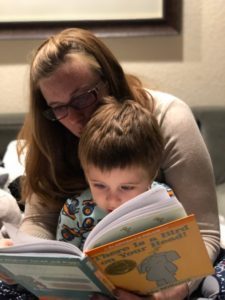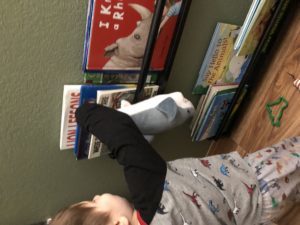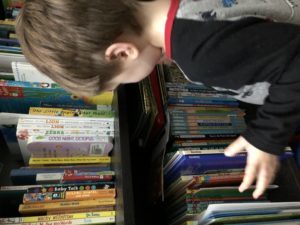Why it’s important to Read Aloud to children
Every January, I start a new reading goal for myself. This year I’ve opted for quality over quantity, by only choosing to read 12 books for 2019. The goal I have set for my son is at least 1-2hrs of reading time a day. It may sound like a lot but really it’s not. At least for our family, it’s not. Our little guy is a bookworm. One of his favorite things to do is visit new bookstores (especially if they have a kids play area). We already read for 30min before bedtime, and usually 10-15 min at nap time. Mealtime is another avenue for story time. Especially right now, with the picky food stage. I have all the time in the world at the dinner table might as well read haha.
Why am I talking about reading to children? All of you know how much I love books and I’ve been reading to my little fellow since the womb. Not too long ago, a good friend of mine and fellow children’s author Rosie Russel, was sharing some insights from a book fair she was attending. She had a table up with a display of all of her books. Her books are all about engaging readers one book at a time. One of the things she mentioned was individuals stating their children were “too young for books.” It always stuns me when I hear people say this. How can a child be too young for books?
 One of the most important things parents can do, beyond keeping kids healthy and safe, is to read with them. That means starting when they are newborns and not even able to talk, and continuing well beyond the years that they can read by themselves. Study after study shows that early reading with children helps them learn to speak, interact, bond with parents and read early themselves, and reading with kids who already know how to read helps them feel close to caretakers, understand the world around them and be empathetic citizens of the world.
One of the most important things parents can do, beyond keeping kids healthy and safe, is to read with them. That means starting when they are newborns and not even able to talk, and continuing well beyond the years that they can read by themselves. Study after study shows that early reading with children helps them learn to speak, interact, bond with parents and read early themselves, and reading with kids who already know how to read helps them feel close to caretakers, understand the world around them and be empathetic citizens of the world.
Read aloud early — and keep it going! The good news, according to the Kids & Family Reading Report by Scholastic, is that more than three out of four parents who have children ages 5 and younger start reading aloud before their child reaches his first birthday. This practice increased to 40 percent in 2016 from 30 percent in 2014 among parents who read aloud before their baby is 3 months old. The research also showed that more parents of 3- to 5-year-olds are reading aloud frequently, with 62 percent of these parents reading aloud five to seven days a week, compared with 55 percent in 2014.
But it’s not all great news: There’s been a drop in parents continuing to read aloud after age 5.
Tip to keep it going: Have fun and be playful. Use this as an opportunity to ham it up and perhaps create different character voices to really engage the child. Don’t be shy about not perfecting the read aloud — especially with little ones. Don’t feel discouraged if a younger child gets distracted or interrupts story time with questions. That’s all part of the learning journey and reading process.
Don’t forget adding books to your home library that showcase diverse storylines and characters. When looking for children’s books to read for fun, both kids (37 percent) and parents (42 percent) mostly agree they “just want a good story” and a similar percentage want books that make kids laugh. One in 10 kids ages 12 to 17 say they specifically look for books that have “culturally or ethnically diverse storylines, settings or characters.”
Tip: Look for stories that showcase different experiences, backgrounds, religions, identities and more to help your child find him or herself in books — as well as learn about other people’s lives. This will teach children the importance of empathy and kindness. One of our favorites is How to Be a Lion by Ed Ver. 
Never forget — choice rules when kids read for fun. Eighty-nine percent of kids ages 6 to 17 agree that the favorite books “are the ones that I have picked out myself.” And book choice starts early, as 67 percent of parents with kids up to age 5 reported that their kids choose the books for read-aloud time. This goes up to 81 percent of parents with kids ages 3 to 5.
Many of the books I want to read at bedtime never get chosen. Unless, I plant them in such a way where they are picked out by his truly! Yes, I have been known to trick him into picking the stories I want to read.
 Tip: Make books accessible. Make sure your bookshelves are low enough for kids to reach the book that they want to read. Keep books by your children’s bedside, in the playroom — all over the house. Bring books with you on car trips, to the grocery store, or even to the doctor’s office waiting room. Rather than handing them a device, hand them a book they love. The more accessible you make books, the more you’ll see their reading frequency grow.
Tip: Make books accessible. Make sure your bookshelves are low enough for kids to reach the book that they want to read. Keep books by your children’s bedside, in the playroom — all over the house. Bring books with you on car trips, to the grocery store, or even to the doctor’s office waiting room. Rather than handing them a device, hand them a book they love. The more accessible you make books, the more you’ll see their reading frequency grow.
Do you have any tips for encouraging reading with children? What are some things you enjoyed about books and storytime with your little ones? Share some of your favorite stories in the comments below to help spread the love of reading.



